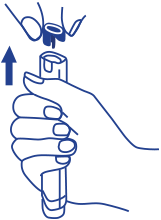
What to do if you
think you have the
symptoms of
anaphylaxis
(severe allergic
reaction)
Anaphylaxis is a severe allergic reaction which can be potentially life-threatening. It should always be treated as a medical emergency, requiring immediate treatment.1
If your doctor or specialist has diagnosed you or your child with the risk of anaphylaxis (severe allergic reaction),
and you believe symptoms have started, EpiPen® Auto-Injector should be used immediately and call 111 for an ambulance.

If you or your child have not been diagnosed with the risk of anaphylaxis (severe allergic reaction),
and you believe symptoms have started, call 111 immediately for an ambulance.
If you're not sure of the signs and symptoms, review the list here.
The following procedure is based on ASCIA Recommendations2
1
2
3
4
5
6
Commence CPR at any time if person is unresponsive and not breathing normally.
Note: ALWAYS give EpiPen® Auto-Injector FIRST, and then asthma reliever puffer if someone with known asthma and allergy to food, insects or medication has SUDDEN BREATHING DIFFICULTY (including wheeze, persistent cough or hoarse voice) even if there are no skin symptoms.
Warning signs
Sometimes, before an anaphylactic reaction occurs, a person experiences milder symptoms. These may include tingling of the skin or abdominal pain and vomiting. These early symptoms can be a useful warning that exposure to a trigger has occurred, and that treatment may be needed.5
Speak to your doctor about the signs and symptoms of anaphylaxis (severe allergic reaction) and learn the warning signs for you or your child.
If you’re unsure if anaphylaxis is occurring it’s better to use EpiPen® Auto-Injector.6,7








